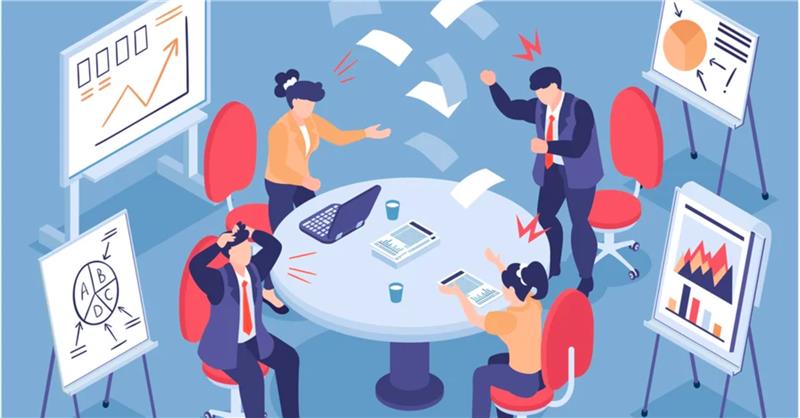I’ve coached and advised C-level executives for decades, and our current context serves as a call to action for high-growth CEOs to step-up and lead environments where honest, open debate and constructive disagreement thrive.
Consider three recent scenarios:
- While conducting a leader-as-coach learning session with an executive team, a provocative comment directed by one leader to another escalated into an unhealthy back and forth exchange. This interaction was personal and unbecoming for any leader, especially a member of the executive team. The two leaders eventually hashed out their differences in private, however with increased pressures to exceed prior year performance, they and the team acknowledged the need to double down on improving collective team culture and productivity.
- A Founder/CEO called in a moment of frustration as two members of the executive team were at odds over conflicting perspectives on business direction and the need to cut staff… again. Each leader accused the other of not getting the bigger picture, of not stepping up as needed, and even questioned the other’s competence. They were now not speaking to each other at a crucial moment of uncertainty and need for measured and mature leadership.
- After completing a team assessment with an executive team and a parallel 360 feedback process, it was clear a Founder/CEO’s ability to lead the company through the next stage was headed squarely in the direction of high-risk team member attrition based primarily on a lack of open, safe, and wanted discourse, and with it, eroding trust across the table.
2024 will surely add fuel to these respective challenges. According to Time.com, more voters than ever in history will head to the polls this year as at least 64 countries (plus the European Union) —representing a combined population of about 49% of world’s population—will hold national elections; the outcomes, and implications of which will undoubtedly be thought-provoking and polarizing.
Productive Dissent with Positive Intent
I’ve seen similar movies before. In 2010, while serving as chief people officer at LivePerson, a conversational AI software company, rapid growth required us to focus on the critical behaviors of discourse and disagreement as catalysts for innovation. We implemented a global leadership framework focused on conscious, connected, informed and influential leadership abilities. Embedded in our system was a leader’s conscious ability to “express and facilitate productive dissent with positive intent.” This was not a coincidence but instead a decision made in response to behavioral undercurrents unfolding around us. A few years later, as chief people officer at the USGA (an antithetical operating environment experiencing strategic and cultural transformation to a digital-first mindset), we focused on a similar set of skills to stay ahead of and respond to rapid change and disruption in sports. And now, in our post-pandemic world and massively disrupted workplace, a leader’s conscious ability to “express and facilitate productive dissent with positive intent” and the many connected skills we had forecasted, are highly sought after and prioritized.
Still, it’s challenging to encourage employees to speak up and create an environment where they feel empowered to voice ideas, concerns, and thoughts on how to solve problems or be opportunistic. Predictably, some high-growth CEOs are “surprised” that in a “see something, say something” world in public spaces, they don’t see the same principles carry over into their workplaces, as employees don’t always abide by the same tenets and ideals. Many of these leaders are often not aware or honest enough with themselves to see that they may be enabling the wrong behaviors or preventing the right behaviors and processes others in their organizations see or want to see and may not be saying something about.
A high-growth CEO may …
- Have a prevailing desire for harmony resulting in groupthink as team members conform to maintain a false sense of agreement, suppressing candor or innovative ideas.
- Lack an understanding of the difference between destructive conflict and constructive disagreement. The team may fear conflict, leading to avoidance, hindering the development of a robust conflict resolution framework.
- Like making decisions without seeking team input, hampering team performance by underusing the capabilities around the table.
- Prevent or lack feedback loops for productive disagreement, continuous improvement, and learning, which is virtually guaranteed to drive disengagement.
Starting Fresh or Getting Re-Tracked
To start or rekindle a leadership environment that promotes productive and healthy debate and disagreement, high-growth CEOs must remember that often-talked about leadership traits (ones they might cynically minimize) such as cultivating psychological safety, active listening, and empathy really do matter. And, while navigating the uncertainties of growth requires situationally directive leadership, leaning in on your roles as active facilitator should not be minimized.
So, as you mobilize your leaders and teams to achieve 2024 goals and objectives in another year of clear uncertainty, consider the following approaches designed to improve the health, quality, and openness of discourse across the executive table and down through your organization:
- If you tend to promote harmony at the expense of disagreement, ensure that individuals feel safe expressing dissent without fear of reprisal; encourage leaders to share their own vulnerabilities; and acknowledge mistakes openly to set a precedent for a psychologically safe environment.
- If you and the team lack an understanding of the differences between destructive conflict and constructive disagreement, remember that destructive conflict creates deep disengagement. Constructive conflict enables diverse ideation.
- If you like making decisions without seeking team input, try to cultivate active and intentional listening skills to understand before being understood. Learn to be a better coach by enabling divergent thinking that may lead you down a new path.
- If you tend to prevent or lack feedback loops for productive disagreement, continuous improvement, and learning (which will guarantee disengagement), consider introducing and applying a process of healthy candor (caring personally while challenging directly). You can be empathetic and understanding while holding people accountable.
For high-growth CEOs and the companies they built or lead, winning is the end game. Still the journey is marked by stress, wins, losses, pivots, crisis, opportunity, and, of course, conflict. Those who free themselves from the constraints which discourage and even stymie healthy and open discourse and disagreement will almost assuredly thrive.


